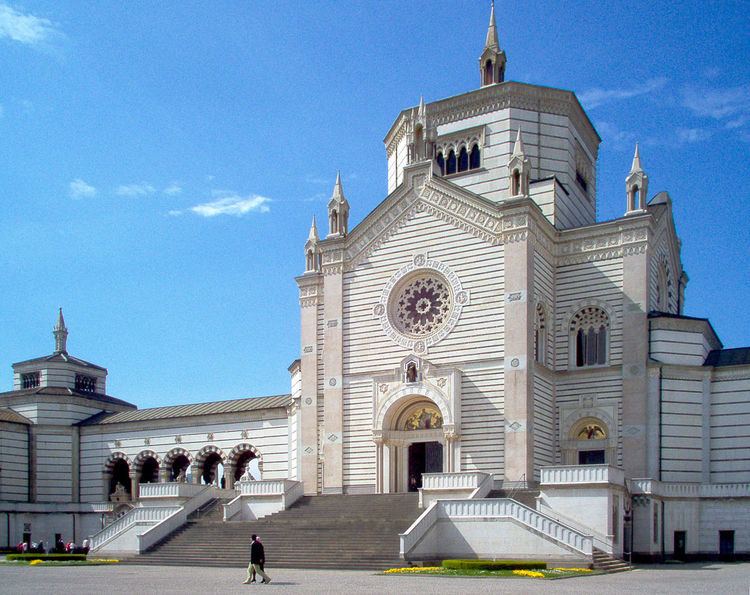Established 1866 Founded 1866 | Website / Phone +39 02 8844 1274 | |
 | ||
Size 250,000 square metres (2,700,000 sq ft) Hours Closed now Saturday8AM–6PMSunday8AM–6PMMondayClosedTuesday8AM–6PMWednesday8AM–6PMThursday8AM–6PMFriday8AM–6PM Similar Monumental Cemetery of Staglie, Parco Sempione, Sforza Castle, San Maurizio al Monaster, Santa Maria delle Grazie | ||
Cimitero monumentale di milano
The Cimitero Monumentale [tʃimiˈtɛːro monumenˈtaːle] ("Monumental Cemetery") is one of the two largest cemeteries in Milan, Italy, the other one being the Cimitero Maggiore. It is noted for the abundance of artistic tombs and monuments.
Contents
- Cimitero monumentale di milano
- Tombe celebri del cimitero monumentale di milano 3 3 3 2012
- The Jewish Section
- Famous graves
- In the media
- References
Designed by the architect Carlo Maciachini (1818–1899), it was planned to consolidate a number of small cemeteries that used to be scattered around the city into a single location.
Officially opened in 1866, it has since then been filled with a wide range of contemporary and classical Italian sculptures as well as Greek temples, elaborate obelisks, and other original works such as a scaled-down version of the Trajan's Column. Many of the tombs belong to noted industrialist dynasties, and were designed by artists such as Giò Ponti, Arturo Martini, Dante Parini, Lucio Fontana, Medardo Rosso, Giacomo Manzù, Floriano Bodini, and Giò Pomodoro.
The main entrance is through the large Famedio, a massive Hall of Fame-like Neo-Medieval style building made of marble and stone that contains the tombs of some of the city's and the country's most honored citizens, including that of novelist Alessandro Manzoni.
The Civico Mausoleo Palanti designed by the architect Mario Palanti is a tomb built for meritorious "Milanesi", or citizens of Milan. The memorial of about 800 Milanese killed in Nazi concentration camps is located in the center and is the work of the group BBPR, formed by leading exponents of Italian rationalist architecture that included Gianluigi Banfi.
The cemetery has a special section for those who do not belong to the Catholic religion and a Jewish section.
Near the entrance there is a permanent exhibition of prints, photographs, and maps outlining the cemetery's historical development. It includes two battery-operated electric hearses built in the 1920s.
Tombe celebri del cimitero monumentale di milano 3 3 3 2012
The Jewish Section
The section, planned by Carlo Maciachini, was opened in 1872 as a substitute for the Jewish cemeteries of Porta Tenaglia, Porta Magenta and Porta Vercellina. It is located east of the catholic cemetery and has a separate entrance. The area is the result of an enlarging of 1913 which added a zone in the southern and eastern direction. The central building was originally the entrance to the cemetery.
The numbering of the tombs is repeated because the cemetery is subdivided into 6 fields and an addition in the eastern side. There are also three common fields one of which for children, with burials between 1873 and 1894, with small gravestones with name, surname and date of death in the ground.
The monuments, built between 1866 and our days, are located along the walkways. There are also family shrines, two of which planned by Maciachini, columbariums and ossuaries on the northern and western walls and burials in the central building. The burials are 1778, some of which are in memory of people killed by the nazis in concentration camps or in the lake Maggiore (Meina massacre).
There are many monuments of artistic value built by important architects and sculptors, described in the guide book by Giovanna Ginex and Ornella Selvafolta .
The following architects have worked in the Jewish section: Carlo Maciachini (shrines Davide Leonino e Pisa), Giovanni Battista Bossi (tomb Anselmo de Benedetti), Ercole Balossi Merlo (shrine Leon David Levi), Luigi Conconi (shrine Segre), Giovanni Ceruti (shrine Vitali), Carlo Meroni (tomb Taranto), Cesare Mazzocchi (shrine Giulio Foligno), Manfredo d'Urbino (shrine Jarach, tomb Mayer, tomb Besso, Monument to the Jewish Martyrs of Nazism), Gigiotti Zanini (tomb Zanini), Adolfo Valabrega (shrine Moisé Foligno), Luigi Perrone (shrine Goldfinger) and the sculptors Mario Quadrelli (shrine Pisa), Giuseppe Daniele Benzoni (tomb Ottolenghi Finzi), Luigi Vimercati (tomb Estella Jung), Agostino Caravati (tomb Alessandro Forti), Rizzardo Galli (tomb Vittorio Finzi), Enrico Cassi (tomb De Daninos), Attilio Prendoni (tomb Errera and Conforti), Eduardo Ximenes (shrine Treves), Giulio Branca (tomb Giovanni Norsa), fratelli Bonfanti (tomb Davide and Beniamino Foà), Enrico Astorri (tomb Carolina Padova e Fanny Levi Cammeo), Egidio Boninsegna (tomb Giuseppe Levi), Dario Viterbo (colombarium Levi Minzi), Giannino Castiglioni (tombs Ettore Levis and Goldfinger), Adolfo Wildt (tomb Cesare Sarfatti), Eugenio Pellini (tomb Bettino Levi), Arrigo Minerbi (tomb Renato del Mar), Roberto Terracini (tomb Nino Colombo).
The central building was enriched in May 2015 with artistic windows representing the 12 Israel tribes by artist Diego Pennacchio Ardemagni.
Famous graves
Signals located throughout the cemetery point visitors to several of the most remarkable tombs and monuments. Some of the persons interred in the cemetery include:
In the media
The Hall of Fame of the Cimitero Monumentale is prominently featured in a climactic scene of the Luca Guadagnino's film I Am Love (2009).
